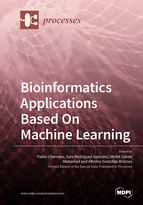Bioinformatics Applications Based On Machine Learning
A special issue of Processes (ISSN 2227-9717). This special issue belongs to the section "Biological Processes and Systems".
Deadline for manuscript submissions: closed (15 December 2020) | Viewed by 48807
Special Issue Editors
Interests: smart cities; machine learning; IoT
Special Issues, Collections and Topics in MDPI journals
Interests: artificial intelligence; distributed computing; machine learning; bioinformatics
Special Issues, Collections and Topics in MDPI journals
Interests: artificial intelligence and intelligent systems; bioinformatics and computational biology
Special Issues, Collections and Topics in MDPI journals
Interests: smart cities; IoT; Industry 4.0; machine learning; artificial intelligence natural language processing; computational technologies; sentiment analysis
Special Issues, Collections and Topics in MDPI journals
Special Issue Information
Dear Colleagues,
Research in the area of bioinformatics has always been one of the most active lines of research in the scientific community. However, it has gained even more interest thanks to the increased processing capacities of computers, which allow processing large volumes of data and analyzing them with techniques such as machine learning.
Thanks to these advances, new applications appear in the area of bioinformatics. In them, the results obtained generally improve those of previous applications that do not use these computation techniques.
In this Special Issue, we seek research and case studies that demonstrate the application of machine learning to support applied scientific research, in any area of bioinformatics. Example topics include (but are not limited to) the following topics applied to bioinformatics:
- New machine learning algorithms
- Distributed machine learning systems
- New applications on bioinformatics
- Health-care applications
- Bio imaging
- Next generation sequencing
- Data and software integration
- Visualization of biological systems and networks
- High-throughput data analysis (transcriptomics, proteomics, etc)
- Comparison and alignment methods
Dr. Pablo Chamoso
Dr. Sara Rodríguez González
Prof. Dr. Mohd Saberi Mohamad
Dr. Alfonso González Briones
Guest editors
Manuscript Submission Information
Manuscripts should be submitted online at www.mdpi.com by registering and logging in to this website. Once you are registered, click here to go to the submission form. Manuscripts can be submitted until the deadline. All submissions that pass pre-check are peer-reviewed. Accepted papers will be published continuously in the journal (as soon as accepted) and will be listed together on the special issue website. Research articles, review articles as well as short communications are invited. For planned papers, a title and short abstract (about 100 words) can be sent to the Editorial Office for announcement on this website.
Submitted manuscripts should not have been published previously, nor be under consideration for publication elsewhere (except conference proceedings papers). All manuscripts are thoroughly refereed through a single-blind peer-review process. A guide for authors and other relevant information for submission of manuscripts is available on the Instructions for Authors page. Processes is an international peer-reviewed open access monthly journal published by MDPI.
Please visit the Instructions for Authors page before submitting a manuscript. The Article Processing Charge (APC) for publication in this open access journal is 2400 CHF (Swiss Francs). Submitted papers should be well formatted and use good English. Authors may use MDPI's English editing service prior to publication or during author revisions.
Keywords
- bioinformatics applications
- machine learning
- artificial intelligence









